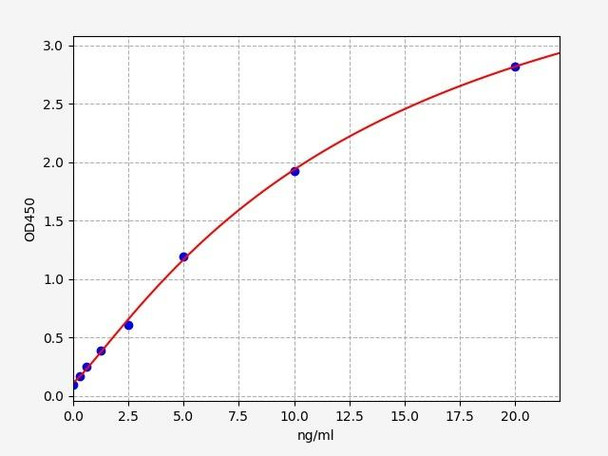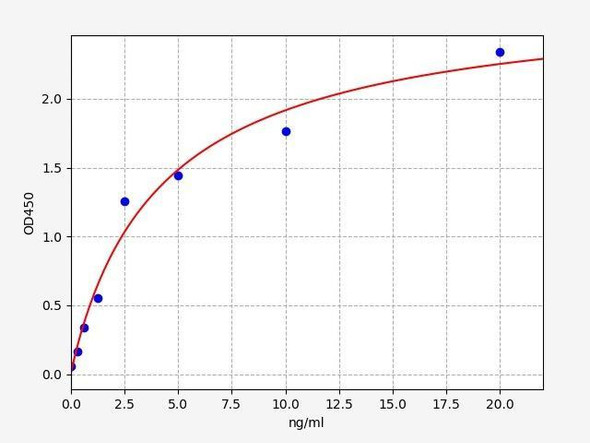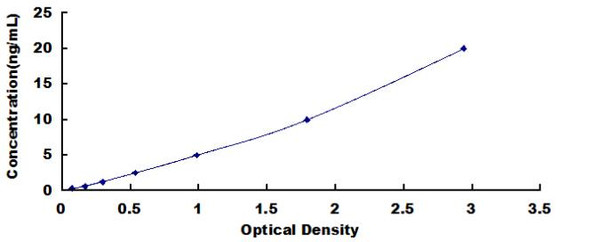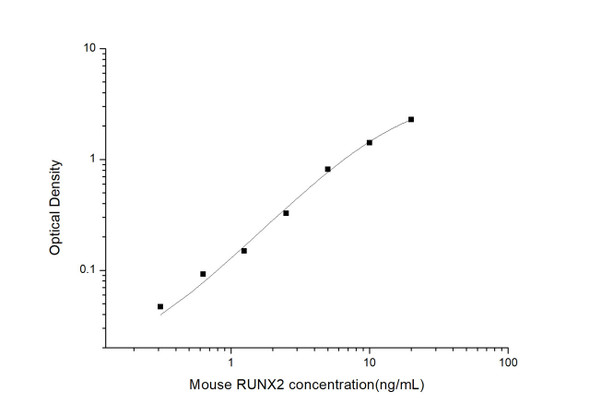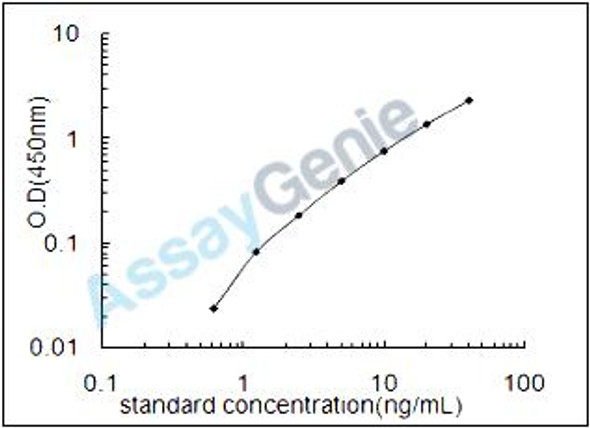Mouse RUNX2 ELISA Kit (MOFI01084)
- SKU:
- MOFI01084
- Product Type:
- ELISA Kit
- Size:
- 96 Assays
- Uniprot:
- Q08775
- Sensitivity:
- 0.188ng/ml
- Range:
- 0.313-20ng/ml
- ELISA Type:
- Sandwich
- Synonyms:
- RUNX2, CBFA1, Acute myeloid leukemia 3 protein, AML3CCD, Core-binding factor subunit alpha-1, PEA2-alpha A, PEBP2A, PEBP2A1CCD1, PEBP2aA1, PEBP2-alpha A, runt domain, alpha subunit 1, runt-related transcription factor 2, SL3, AKV core-binding factor
- Reactivity:
- Mouse
- Research Area:
- Developmental Biology
Description
Mouse RUNX2 ELISA Kit
The Mouse RUNX2 ELISA Kit from Assay Genie is specifically designed for the precise detection of RUNX2 levels in mouse serum, plasma, and cell culture supernatants. This ELISA kit offers high sensitivity and specificity, ensuring accurate and reproducible results for a variety of research applications.RUNX2 is a vital transcription factor that plays a crucial role in regulating bone development and osteoblast differentiation. Dysregulation of RUNX2 has been linked to various bone-related disorders, including osteoporosis and skeletal abnormalities.
Studying the levels of RUNX2 can provide valuable insights into bone metabolism and potential therapeutic strategies.Overall, the Mouse RUNX2 ELISA Kit is an indispensable tool for researchers studying bone physiology, skeletal disorders, and potential treatments related to RUNX2. With its reliable performance and ease of use, this kit is a valuable addition to any laboratory conducting mouse-specific research.
| Product Name: | Mouse RUNX2 ELISA Kit |
| Product Code: | MOFI01084 |
| Size: | 96 Assays |
| Alias: | RUNX2, CBFA1, Acute myeloid leukemia 3 protein, AML3CCD, Core-binding factor subunit alpha-1, PEA2-alpha A, PEBP2A, PEBP2A1CCD1, PEBP2aA1, PEBP2-alpha A, runt domain, alpha subunit 1, runt-related transcription factor 2, SL3, AKV core-binding factor alpha A subunit, SL3-3 enhancer factor 1 alpha A subunit |
| Detection Method: | Sandwich ELISA |
| Application: | This immunoassay kit allows for the in vitro quantitative determination of Mouse RUNX2 concentrations in serum plasma and other biological fluids. |
| Sensitivity: | 0.188ng/ml |
| Range: | 0.313-20ng/ml |
| Storage: | 4°C for 6 months |
| Note: | For Research Use Only |
| Recovery: | Matrices listed below were spiked with certain level of Mouse RUNX2 and the recovery rates were calculated by comparing the measured value to the expected amount of Mouse RUNX2 in samples. | ||||||||||||||||
| |||||||||||||||||
| Linearity: | The linearity of the kit was assayed by testing samples spiked with appropriate concentration of Mouse RUNX2 and their serial dilutions. The results were demonstrated by the percentage of calculated concentration to the expected. | ||||||||||||||||
| |||||||||||||||||
| Intra Assay: | CV <8% | ||||||||||||||||
| Inter Assay: | CV <10% |
| Component | Quantity | Storage |
| ELISA Microplate (Dismountable) | 8×12 strips | 4°C for 6 months |
| Lyophilized Standard | 2 | 4°C/-20°C |
| Sample/Standard Dilution Buffer | 20ml | 4°C |
| Biotin-labeled Antibody(Concentrated) | 120ul | 4°C (Protect from light) |
| Antibody Dilution Buffer | 10ml | 4°C |
| HRP-Streptavidin Conjugate(SABC) | 120ul | 4°C (Protect from light) |
| SABC Dilution Buffer | 10ml | 4°C |
| TMB Substrate | 10ml | 4°C (Protect from light) |
| Stop Solution | 10ml | 4°C |
| Wash Buffer(25X) | 30ml | 4°C |
| Plate Sealer | 5 | - |
Other materials and equipment required:
- Microplate reader with 450 nm wavelength filter
- Multichannel Pipette, Pipette, microcentrifuge tubes and disposable pipette tips
- Incubator
- Deionized or distilled water
- Absorbent paper
- Buffer resevoir
| Uniprot | Q08775 |
| UniProt Protein Function: | AML3: Transcription factor involved in osteoblastic differentiation and skeletal morphogenesis. Essential for the maturation of osteoblasts and both intramembranous and endochondral ossification. CBF binds to the core site, 5'- PYGPYGGT-3', of a number of enhancers and promoters, including murine leukemia virus, polyomavirus enhancer, T-cell receptor enhancers, osteocalcin, osteopontin, bone sialoprotein, alpha 1(I) collagen, LCK, IL-3 and GM-CSF promoters. In osteoblasts, supports transcription activation: synergizes with SPEN/MINT to enhance FGFR2-mediated activation of the osteocalcin FGF-responsive element (OCFRE). Inhibits KAT6B-dependent transcriptional activation. Interaction with SATB2 results in enhanced DNA binding and transactivation by these transcription factors. Heterodimer of an alpha and a beta subunit. Interacts with HIVEP3 and HIPK3. The alpha subunit binds DNA as a monomer and through the Runt domain. DNA-binding is increased by heterodimerization. Interacts with XRCC6 (Ku70) and XRCC5 (Ku80). Interacts with KAT6A and KAT6B. Binds to cyclin B1 CCNB1. Interacts with DDX5. Specifically expressed in osteoblasts. 3 isoforms of the human protein are produced by alternative splicing. |
| UniProt Protein Details: | Protein type:Transcription factor; DNA-binding Chromosomal Location of Human Ortholog: 6p21 Cellular Component: nucleoplasm; transcription factor complex; cytoplasm; nuclear chromatin Molecular Function:protein domain specific binding; protein binding; bHLH transcription factor binding; chromatin binding; transcription factor activity; ATP binding Biological Process: embryonic forelimb morphogenesis; transcription initiation from RNA polymerase II promoter; ossification; positive regulation of transcription, DNA-dependent; cell maturation; regulation of fibroblast growth factor receptor signaling pathway; chondrocyte development; embryonic cranial skeleton morphogenesis; stem cell differentiation; osteoblast development; odontogenesis of dentine-containing teeth; BMP signaling pathway; osteoblast differentiation; positive regulation of osteoblast differentiation; positive regulation of chondrocyte differentiation; negative regulation of smoothened signaling pathway; positive regulation of cell proliferation; gene expression; negative regulation of transcription, DNA-dependent; regulation of odontogenesis of dentine-containing teeth; osteoblast fate commitment; T cell differentiation; endochondral ossification Disease: Metaphyseal Dysplasia With Maxillary Hypoplasia With Or Without Brachydactyly; Cleidocranial Dysplasia |
| NCBI Summary: | This gene is a member of the RUNX family of transcription factors and encodes a nuclear protein with an Runt DNA-binding domain. This protein is essential for osteoblastic differentiation and skeletal morphogenesis and acts as a scaffold for nucleic acids and regulatory factors involved in skeletal gene expression. The protein can bind DNA both as a monomer or, with more affinity, as a subunit of a heterodimeric complex. Two regions of potential trinucleotide repeat expansions are present in the N-terminal region of the encoded protein, and these and other mutations in this gene have been associated with the bone development disorder cleidocranial dysplasia (CCD). Transcript variants that encode different protein isoforms result from the use of alternate promoters as well as alternate splicing. [provided by RefSeq, Jul 2016] |
| UniProt Code: | Q08775 |
| NCBI GenInfo Identifier: | 17368460 |
| NCBI Gene ID: | 860 |
| NCBI Accession: | Q13950.2 |
| UniProt Secondary Accession: | Q08775,Q08775, Q9Z2J9, |
| UniProt Related Accession: | Q13950 |
| Molecular Weight: | |
| NCBI Full Name: | Runt-related transcription factor 2 |
| NCBI Synonym Full Names: | RUNX family transcription factor 2 |
| NCBI Official Symbol: | RUNX2 |
| NCBI Official Synonym Symbols: | CCD; AML3; CCD1; CLCD; OSF2; CBFA1; OSF-2; PEA2aA; PEBP2aA; CBF-alpha-1 |
| NCBI Protein Information: | runt-related transcription factor 2 |
| UniProt Protein Name: | Runt-related transcription factor 2 |
| UniProt Synonym Protein Names: | Acute myeloid leukemia 3 protein; Core-binding factor subunit alpha-1; CBF-alpha-1; Oncogene AML-3; Osteoblast-specific transcription factor 2; OSF-2; Polyomavirus enhancer-binding protein 2 alpha A subunit; PEA2-alpha A; PEBP2-alpha A; SL3-3 enhancer factor 1 alpha A subunit; SL3/AKV core-binding factor alpha A subunit |
| Protein Family: | Runt-related transcription factor |
| UniProt Gene Name: | RUNX2 |
| UniProt Entry Name: | RUNX2_HUMAN |
*Note: Protocols are specific to each batch/lot. For the correct instructions please follow the protocol included in your kit.
| Step | Procedure |
| 1. | Set standard, test sample and control (zero) wells on the pre-coated plate respectively, and then, record their positions. It is recommended to measure each standard and sample in duplicate. Wash plate 2 times before adding standard, sample and control (zero) wells! |
| 2. | Aliquot 0.1ml standard solutions into the standard wells. |
| 3. | Add 0.1 ml of Sample / Standard dilution buffer into the control (zero) well. |
| 4. | Add 0.1 ml of properly diluted sample (Human serum, plasma, tissue homogenates and other biological fluids.) into test sample wells. |
| 5. | Seal the plate with a cover and incubate at 37 °C for 90 min. |
| 6. | Remove the cover and discard the plate content, clap the plate on the absorbent filter papers or other absorbent material. Do NOT let the wells completely dry at any time. Wash plate X2. |
| 7. | Add 0.1 ml of Biotin- detection antibody working solution into the above wells (standard, test sample & zero wells). Add the solution at the bottom of each well without touching the side wall. |
| 8. | Seal the plate with a cover and incubate at 37°C for 60 min. |
| 9. | Remove the cover, and wash plate 3 times with Wash buffer. Let wash buffer rest in wells for 1 min between each wash. |
| 10. | Add 0.1 ml of SABC working solution into each well, cover the plate and incubate at 37°C for 30 min. |
| 11. | Remove the cover and wash plate 5 times with Wash buffer, and each time let the wash buffer stay in the wells for 1-2 min. |
| 12. | Add 90 µL of TMB substrate into each well, cover the plate and incubate at 37°C in dark within 10-20 min. (Note: This incubation time is for reference use only, the optimal time should be determined by end user.) And the shades of blue can be seen in the first 3-4 wells (with most concentrated standard solutions), the other wells show no obvious color. |
| 13. | Add 50 µL of Stop solution into each well and mix thoroughly. The color changes into yellow immediately. |
| 14. | Read the O.D. absorbance at 450 nm in a microplate reader immediately after adding the stop solution. |
When carrying out an ELISA assay it is important to prepare your samples in order to achieve the best possible results. Below we have a list of procedures for the preparation of samples for different sample types.
| Sample Type | Protocol |
| Serum: | If using serum separator tubes, allow samples to clot for 30 minutes at room temperature. Centrifuge for 10 minutes at 1,000x g. Collect the serum fraction and assay promptly or aliquot and store the samples at -80°C. Avoid multiple freeze-thaw cycles. If serum separator tubes are not being used, allow samples to clot overnight at 2-8°C. Centrifuge for 10 minutes at 1,000x g. Remove serum and assay promptly or aliquot and store the samples at -80°C. Avoid multiple freeze-thaw cycles. |
| Plasma: | Collect plasma using EDTA or heparin as an anticoagulant. Centrifuge samples at 4°C for 15 mins at 1000 × g within 30 mins of collection. Collect the plasma fraction and assay promptly or aliquot and store the samples at -80°C. Avoid multiple freeze-thaw cycles. Note: Over haemolysed samples are not suitable for use with this kit. |
| Urine & Cerebrospinal Fluid: | Collect the urine (mid-stream) in a sterile container, centrifuge for 20 mins at 2000-3000 rpm. Remove supernatant and assay immediately. If any precipitation is detected, repeat the centrifugation step. A similar protocol can be used for cerebrospinal fluid. |
| Cell culture supernatant: | Collect the cell culture media by pipette, followed by centrifugation at 4°C for 20 mins at 1500 rpm. Collect the clear supernatant and assay immediately. |
| Cell lysates: | Solubilize cells in lysis buffer and allow to sit on ice for 30 minutes. Centrifuge tubes at 14,000 x g for 5 minutes to remove insoluble material. Aliquot the supernatant into a new tube and discard the remaining whole cell extract. Quantify total protein concentration using a total protein assay. Assay immediately or aliquot and store at ≤ -20°C. |
| Tissue homogenates: | The preparation of tissue homogenates will vary depending upon tissue type. Rinse tissue with 1X PBS to remove excess blood & homogenize in 20ml of 1X PBS (including protease inhibitors) and store overnight at ≤ -20°C. Two freeze-thaw cycles are required to break the cell membranes. To further disrupt the cell membranes you can sonicate the samples. Centrifuge homogenates for 5 mins at 5000xg. Remove the supernatant and assay immediately or aliquot and store at -20°C or -80°C. |
| Tissue lysates: | Rinse tissue with PBS, cut into 1-2 mm pieces, and homogenize with a tissue homogenizer in PBS. Add an equal volume of RIPA buffer containing protease inhibitors and lyse tissues at room temperature for 30 minutes with gentle agitation. Centrifuge to remove debris. Quantify total protein concentration using a total protein assay. Assay immediately or aliquot and store at ≤ -20 °C. |
| Breast Milk: | Collect milk samples and centrifuge at 10,000 x g for 60 min at 4°C. Aliquot the supernatant and assay. For long term use, store samples at -80°C. Minimize freeze/thaw cycles. |

